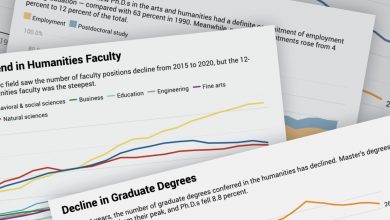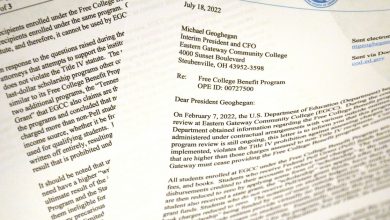Antioch and Otterbein Tie the Knot

[ad_1]
In Otterbein, which enrolled about 2,600 students last fall, Antioch found a partner that could serve as a feeder for its low-residency and online graduate programs, offered at a small constellation of four campuses located on the nation’s coasts. In Antioch, which enrolled about 3,400 students last year, Otterbein found an institution that offers more opportunities for its (mostly) undergraduate students to pursue graduate degrees.
“All the folks that connect with our universities and connect with higher education will be excited about what we’re putting together and starting and launching today,” John L. Comerford, president of Otterbein, said during a news conference on his campus.
News of mergers and acquisitions in higher education are hardly new and are likely to increase in number in coming years as many colleges grapple with falling enrollment, increased operating costs, and pressures to limit tuition increases.
But the mergers and acquisitions of the past decade, typically one of two varieties, have had their downsides. In one scenario, a public governing board combines two or more colleges to create efficiencies of scale, but this leads to cuts in programs and layoffs of faculty. In another scenario, a small, failing private college is absorbed by a larger institution, but this mostly eliminates the identity and autonomy of the acquired college.
The arrangement between Antioch and Otterbein took more than two years to develop and is meant to define a different kind of relationship between two colleges, a win-win that creates a mostly equal partnership rather than a takeover. The regulatory approvals are expected to take a year, according to a news release, and new programs could be available as soon as the fall 2023 semester.
The institutions have agreed, in principle, to what they are calling a national “system,” allowing each college to retain its name and degree programs, while also collaborating on some graduate and continuing-education programs. They also plan to create a third entity to share the costs of some administrative functions; one change that is likely to result in some staff reduction. The result, college leaders said, is a partnership that is meant to offer students more options rather than fewer.
“We approach this with the notion that one plus one plus one has to add up to more than three,” said William R. Groves, chancellor of Antioch, which has its headquarters, but no campus, in Ohio.
Higher-education experts said the new arrangement is promising and could set the stage for other institutions to pursue a similar relationship.
The differences are complementary, said David Weerts, a professor of organizational leadership, policy, and development at the University of Minnesota. The venture also makes sense, he said, because both colleges share a similar progressive mission, based on social justice and equity, and are not just joining forces based on geography.
For too long, colleges have resisted this approach, thinking that their special identity would be lost through any kind of partnership, said Rick Staisloff, a higher-education consultant with the rpk Group.
But the financial pressures on higher education, driven largely by falling enrollments, makes this kind of deal more likely, he said, as well as more palatable to colleges: “We will see far more activity like this than we will mergers and acquisitions.”
Groves said an affiliation has been part of his plan for Antioch since he took over as chancellor in 2016. The university, with its various branch campuses, was the surviving half of a previous partnership with Antioch College, a residential liberal-arts college in Ohio that closed in 2008 and reopened three years later as a separate institution.
While the university remains, it has little endowment to sustain it, Groves said, and needs a steady stream of undergraduates to help sustain it financially.
In December 2020, a working group at the university, including some 20 faculty members, identified a group of nearly 250 colleges who might be potential partners, said Groves. By late January 2021, that list was whittled to 60, who were contacted to see if they were interested, he said. Within three months, 13 of those colleges had responded with letters of interest.

Michael Theis, The Chronicle
The university also engaged the Association of Governing Boards and the Royal Bank of Canada to make sure the potential partners were a good fit financially and had a similar mission.
They weren’t about to take just anyone, Groves said. Like Antioch, the partner college had to be committed to social, economic, and environmental justice, and they didn’t want an institution that was in dire financial straits. In addition, he said, the working group set some boundaries over what they wanted to preserve in the relationship, including the name of the university and their own governing board.
“We wanted a justice league, not just a business proposition,” Groves said.
Antioch settled on four finalists and met with representatives of each institution in June of 2021, Groves said, and then it continued discussions with two colleges, including Otterbein.
One institution was ruled out because of financial concerns, Groves said in an email, even though its mission aligned with Antioch and it had interesting possibilities for collaborative programs.
“Our concern,” he said, “was the amount of debt they carried and their declining enrollment numbers.”
Kenneth Baker, chair of Antioch’s M.B.A. program and co-chair of the faculty senate, said his colleagues had a lot of concerns about the outcome until they learned the partner institution was Otterbein. Choosing a college that has a similar mission eased worries that they would have to change their business curriculum from one that is focused on social welfare and the environment as well as profits.
For some Otterbein faculty, the announced system is a step toward improving Otterbein’s revenues after some lean years. “I think the president has been clear that you can’t cut your way to success, so growing programs and innovating has been the theme,” said Meredith C. Frey, a professor of psychology at Otterbein.
Frey said she is excited that her undergraduates will have a new pathway to a graduate degree in that field. “We don’t have the ability to grow our own graduate programs,” she said.
Employment conditions for faculty members will remain unchanged at each college, with tenure at Otterbein and multiyear contracts at Antioch, according to college officials.
Conversations about these kinds of partnerships are becoming normalized among presidents and boards. They’re not waiting for a crisis to pursue this.
A lot of work remains before any new programs can be announced. The accreditor that oversees both institutions has to approve the plans, as does the U.S. Department of Education. A system board will have to be established and set clear guidelines about how each partner will contribute and, ideally, benefit financially from the arrangement.
There are risks, too, said Comerford, president of Otterbein, including if the venture doesn’t work as well financially as they hoped. Both colleges are also concerned about this arrangement being perceived as a takeover by the other, he said.
Higher-education advocates see the system announcement as a sign that partnerships are no longer seen as a sign of desperation, a measure to be pursued as a last-ditch effort to save the college.
Indeed, other institutions are already expressing interest in the possibility of joining. Since the announcement, Groves said, more than a dozen colleges have reached out to explore membership.
Staisloff, the consultant, said what makes this arrangement interesting and quite different from other consortiums is that it could possibly expand to other institutions across the country.
Marjorie Hass, president of the Council of Independent Colleges, said her membership has been very interested in the partnership between Antioch and Otterbein.
“Conversations about these kinds of partnerships are becoming normalized among presidents and boards. They’re not waiting for a crisis to pursue this.”
[ad_2]
Source link






